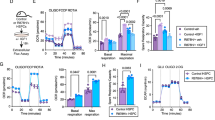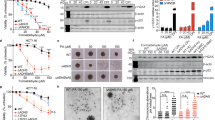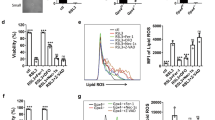Abstract
Haematopoietic stem cells (HSCs) regenerate blood cells throughout the lifespan of an organism. With age, the functional quality of HSCs declines, partly owing to the accumulation of damaged DNA1,2,3. However, the factors that damage DNA and the protective mechanisms that operate in these cells are poorly understood. We have recently shown that the Fanconi anaemia DNA-repair pathway counteracts the genotoxic effects of reactive aldehydes4,5. Mice with combined inactivation of aldehyde catabolism (through Aldh2 knockout) and the Fanconi anaemia DNA-repair pathway (Fancd2 knockout) display developmental defects, a predisposition to leukaemia, and are susceptible to the toxic effects of ethanol—an exogenous source of acetaldehyde4. Here we report that aged Aldh2−/−Fancd2−/− mutant mice that do not develop leukaemia spontaneously develop aplastic anaemia, with the concomitant accumulation of damaged DNA within the haematopoietic stem and progenitor cell (HSPC) pool. Unexpectedly, we find that only HSPCs, and not more mature blood precursors, require Aldh2 for protection against acetaldehyde toxicity. Additionally, the aldehyde-oxidizing activity of HSPCs, as measured by Aldefluor stain, is due to Aldh2 and correlates with this protection. Finally, there is more than a 600-fold reduction in the HSC pool of mice deficient in both Fanconi anaemia pathway-mediated DNA repair and acetaldehyde detoxification. Therefore, the emergence of bone marrow failure in Fanconi anaemia is probably due to aldehyde-mediated genotoxicity restricted to the HSPC pool. These findings identify a new link between endogenous reactive metabolites and DNA damage in HSCs, and define the protective mechanisms that counteract this threat.
This is a preview of subscription content, access via your institution
Access options
Subscribe to this journal
Receive 51 print issues and online access
$199.00 per year
only $3.90 per issue
Buy this article
- Purchase on SpringerLink
- Instant access to full article PDF
Prices may be subject to local taxes which are calculated during checkout




Similar content being viewed by others
References
Nijnik, A. et al. DNA repair is limiting for haematopoietic stem cells during ageing. Nature 447, 686–690 (2007)
Rossi, D. J. et al. Deficiencies in DNA damage repair limit the function of haematopoietic stem cells with age. Nature 447, 725–729 (2007)
Niedernhofer, L. J. DNA repair is crucial for maintaining hematopoietic stem cell function. DNA Repair (Amst.) 7, 523–529 (2008)
Langevin, F., Crossan, G. P., Rosado, I. V., Arends, M. J. & Patel, K. J. Fancd2 counteracts the toxic effects of naturally produced aldehydes in mice. Nature 475, 53–58 (2011)
Rosado, I. V., Langevin, F., Crossan, G. P., Takata, M. & Patel, K. J. Formaldehyde catabolism is essential in cells deficient for the Fanconi anemia DNA-repair pathway. Nature Struct. Mol. Biol. 18, 1432–1434 (2011)
Rogakou, E. P., Pilch, D. R., Orr, A. H., Ivanova, V. S. & Bonner, W. M. DNA double-stranded breaks induce histone H2AX phosphorylation on serine 139. J. Biol. Chem. 273, 5858–5868 (1998)
Houghtaling, S. et al. Epithelial cancer in Fanconi anemia complementation group D2 (Fancd2) knockout mice. Genes Dev. 17, 2021–2035 (2003)
Crossan, G. P. et al. Disruption of mouse Slx4, a regulator of structure-specific nucleases, phenocopies Fanconi anemia. Nature Genet. 43, 147–152 (2011)
Kutler, D. I. et al. A 20-year perspective on the International Fanconi Anemia Registry (IFAR). Blood 101, 1249–1256 (2003)
McCulloch, E. A. & Till, J. E. The radiation sensitivity of normal mouse bone marrow cells, determined by quantitative marrow transplantation into irradiated mice. Radiat. Res. 13, 115–125 (1960)
Meagher, R. C., Sieber, F. & Spivak, J. L. Suppression of hematopoietic-progenitor-cell proliferation by ethanol and acetaldehyde. N. Engl. J. Med. 307, 845–849 (1982)
Becker, A. J., Mc, C. E. & Till, J. E. Cytological demonstration of the clonal nature of spleen colonies derived from transplanted mouse marrow cells. Nature 197, 452–454 (1963)
Balber, A. E. Concise review: aldehyde dehydrogenase bright stem and progenitor cell populations from normal tissues: characteristics, activities, and emerging uses in regenerative medicine. Stem Cells 29, 570–575 (2011)
Armstrong, L. et al. Phenotypic characterization of murine primitive hematopoietic progenitor cells isolated on basis of aldehyde dehydrogenase activity. Stem Cells 22, 1142–1151 (2004)
Storms, R. W. et al. Distinct hematopoietic progenitor compartments are delineated by the expression of aldehyde dehydrogenase and CD34. Blood 106, 95–102 (2005)
Storms, R. W. et al. Isolation of primitive human hematopoietic progenitors on the basis of aldehyde dehydrogenase activity. Proc. Natl Acad. Sci. USA 96, 9118–9123 (1999)
Levi, B. P., Yilmaz, O. H., Duester, G. & Morrison, S. J. Aldehyde dehydrogenase 1a1 is dispensable for stem cell function in the mouse hematopoietic and nervous systems. Blood 113, 1670–1680 (2009)
Hess, D. A. et al. Selection based on CD133 and high aldehyde dehydrogenase activity isolates long-term reconstituting human hematopoietic stem cells. Blood 107, 2162–2169 (2006)
Kiel, M. J., Yilmaz, O. H., Iwashita, T., Terhorst, C. & Morrison, S. J. SLAM family receptors distinguish hematopoietic stem and progenitor cells and reveal endothelial niches for stem cells. Cell 121, 1109–1121 (2005)
Purton, L. E. & Scadden, D. T. Limiting factors in murine hematopoietic stem cell assays. Cell Stem Cell 1, 263–270 (2007)
Rossi, D. J. et al. Cell intrinsic alterations underlie hematopoietic stem cell aging. Proc. Natl Acad. Sci. USA 102, 9194–9199 (2005)
Sudo, K., Ema, H., Morita, Y. & Nakauchi, H. Age-associated characteristics of murine hematopoietic stem cells. J. Exp. Med. 192, 1273–1280 (2000)
Wilson, A. et al. Hematopoietic stem cells reversibly switch from dormancy to self-renewal during homeostasis and repair. Cell 135, 1118–1129 (2008)
Mohrin, M. et al. Hematopoietic stem cell quiescence promotes error-prone DNA repair and mutagenesis. Cell Stem Cell 7, 174–185 (2010)
Szilvassy, S. J., Humphries, R. K., Lansdorp, P. M., Eaves, A. C. & Eaves, C. J. Quantitative assay for totipotent reconstituting hematopoietic stem cells by a competitive repopulation strategy. Proc. Natl Acad. Sci. USA 87, 8736–8740 (1990)
Milyavsky, M. et al. A distinctive DNA damage response in human hematopoietic stem cells reveals an apoptosis-independent role for p53 in self-renewal. Cell Stem Cell 7, 186–197 (2010)
Seita, J., Rossi, D. J. & Weissman, I. L. Differential DNA damage response in stem and progenitor cells. Cell Stem Cell 7, 145–147 (2010)
Crossan, G. P. & Patel, K. J. The Fanconi anaemia pathway orchestrates incisions at sites of crosslinked DNA. J. Pathol. 226, 326–337 (2012)
Ema, H. et al. Adult mouse hematopoietic stem cells: purification and single-cell assays. Nature Protocols 1, 2979–2987 (2006)
Wang, L. J. et al. Engraftment assessment in human and mouse liver tissue after sex-mismatched liver cell transplantation by real-time quantitative PCR for Y chromosome sequences. Liver Transpl. 8, 822–828 (2002)
Drost, R. et al. BRCA1 RING function is essential for tumor suppression but dispensable for therapy resistance. Cancer Cell 20, 797–809 (2011)
Lo Celso, C., Klein, R. J. & Scadden, D. T. Analysis of the hematopoietic stem cell niche. Curr. Protoc. Stem Cell Biol. Chapter 2, Unit 2A 5. (2007)
Zhang, Q. S. et al. Fancd2−/− mice have hematopoietic defects that can be partially corrected by resveratrol. Blood 116, 5140–5148 (2010)
Amrani, Y. M. et al. The Paf oncogene is essential for hematopoietic stem cell function and development. J. Exp. Med. 208, 1757–1765 (2011)
Acknowledgements
We thank M. Grompe for Fancd2-deficient mice and M. Milsom and D. Walter for technical advice. We are grateful to T. Langford, R. Berks, A. Middleton, C. Knox and J. Wiles for their help with mouse experimental work. We would also like to thank the Biomed services and ARES staff for animal husbandry and assistance. We thank N. Grant for photography. We thank the Human Research Tissue Bank (NIHR Cambridge Biomedical Research Centre) for processing histology. We also thank F. Zhang for help with FACS. G.P.C. is supported by CRUK and Homerton College, Cambridge. J.I.G. is supported by the Milstein Fund and the Darwin Trust of Edinburgh. F.L. is supported by the March of Dimes Foundation.
Author information
Authors and Affiliations
Contributions
The study was conceived by K.J.P., G.P.C. and J.I.G. The manuscript was written by K.J.P., G.P.C. and J.I.G. All experiments were planned and executed by J.I.G. and G.P.C. Cell sorting was performed by M.D. Additional analysis of mice with bone marrow failure was conducted by F.L. M.J.A. analysed histological samples and provided useful discussion.
Corresponding author
Ethics declarations
Competing interests
The authors declare no competing financial interests.
Supplementary information
Supplementary Figures
This file contains Supplementary Figures 1-7. (PDF 4465 kb)
Rights and permissions
About this article
Cite this article
Garaycoechea, J., Crossan, G., Langevin, F. et al. Genotoxic consequences of endogenous aldehydes on mouse haematopoietic stem cell function. Nature 489, 571–575 (2012). https://doi.org/10.1038/nature11368
Received:
Accepted:
Published:
Issue Date:
DOI: https://doi.org/10.1038/nature11368



